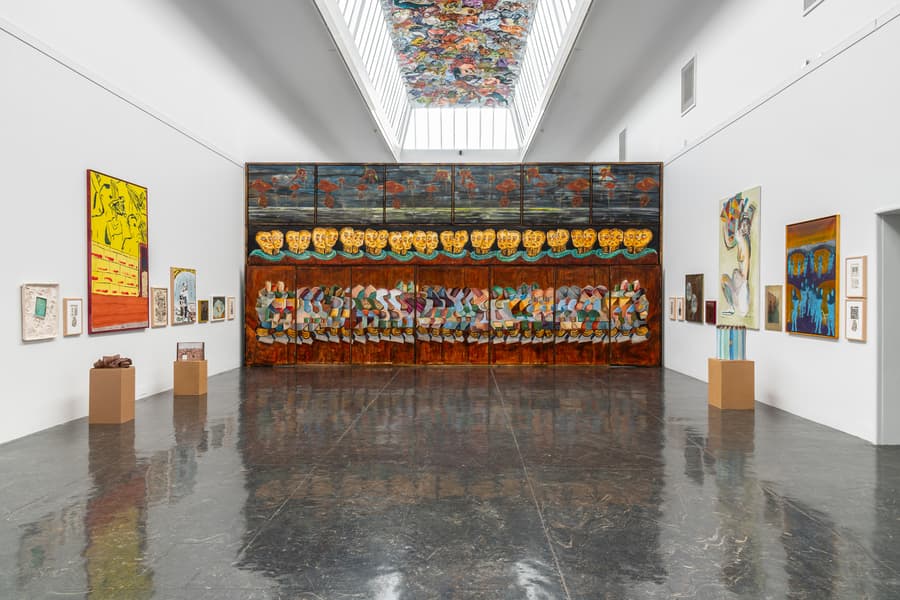Marino Marini (in nasjonalgalleriet)

Arranged by Christian Faerber and Svensk-Franska Konstgalleriet, Kunstnernes Hus and Nasjonalgalleriet.
Marino Marini has recently featured in the press and in international art literature at increasingly shorter intervals. Museums and private collections in America and Europe have acquired his works and public honors have also given him a place in the public consciousness.
When you are faced with Marini's work, you hardly find it any longer surprising that his name, in just a few years and independent of borders and current opinions about art, has gained the resonance it has today. Perhaps one can ask why international progress has only recently come to an almost fifty-year-old artist who has long been highly regarded in his home country.
Fascist Italy had certainly not, like Germany, stifled all genuine artistic expression. It could also never succeed with a people who for centuries have known how to save their culture through harder trials than state guardianship. But the points of irritation were numerous.
The artistic life was circumscribed in many ways and Italy's external relations were quite delicate at this time. It was not until several years after the war that the cultural exchange started again, and here it may be appropriate to mention a pioneer of modern art Curt Valentin in New York, who has contributed more to making Marini internationally known than the considerable number of monographs and articles about the artist which has subsequently been published.
Marino Marini was born in 1901 in Pistoia; in this Tuscany whose artistic roots go all the way back to the Etruscans in the sixth century BC. Already in his young years he was fascinated by Etruscan art, and he has constantly maintained the impulses it has given him. Long-term studies at the Accademia di Belle Arti in Florence, a long stay in Paris 1928-29 travels through Europe, the encounters with early medieval sculpture, with Chinese and Egyptian art encounters of an essential nature which stimulated related tendencies in himself. Then again Paris in the years of artistic reassessments. He takes the impression of modernism. From time to time, Picasso exerts a strong attraction.
But Marini never loses touch with tradition, with the art of his homeland. The realistic connection remains. The form grows organically: clear, firm, sensual. Detours and intellectual oddities await him. "There are many truths in art", he says, "and you have to stick to the one you have recognized to yourself as the right one". This means stability and conscious limitation and at the same time a constant renewal from within: the richest variety within a closed circle of motifs. Above all, he seeks the truly plastic, the dynamism of sculpture in cooperation, "in dialogue" with the surrounding space. Nevertheless, he does not shy away from painterly means, nor does he allow the material to dominate the organic connection of the artwork. However refined he treats the surface of his sculptures, it is never to achieve random effects. The vehemence of the movement, the sometimes ascetic, grotesque or fragmentary nature is not lost in the episode. - One wanted to find traces of mystery in Marini, an anti-classical attitude seems to confirm this. But strict legality and a strong expansive pathos in his work preclude any skeptical or destructive attitude. His attitude to the outside world and his artistic creation is free from pessimism — that is also a typical Italian trait in him.
1929-40 Marini taught at the art school in Monza and in 1940 he became professor of sculpture at the Accademia di Brera in Milan. As early as 1935, he received the major sculpture prize at the 12th Quadriennale in Rome. Several honors had previously been awarded to him and others followed. When at the 1952 Biennale he received the city of Venice's great sculpture prize — the international prize cannot be awarded to an Italian since Italy hosts the Biennale. Venice honored a man whose name had already won recognition as one of the greats of modern art.
Before this exhibition, Marini was a relatively unknown artist in the Nordic region. Only a few Scandinavians had seen his work in museums or at exhibitions abroad. The Gothenburg Museum of Art did indeed have a work by him earlier.
Now he is also represented in the Statens Museum for Art, Copenhagen and in the National Museum, Stockholm — and not long ago he was named an honorary member of the Royal Academy of Free Arts.
-Christian Faerber


